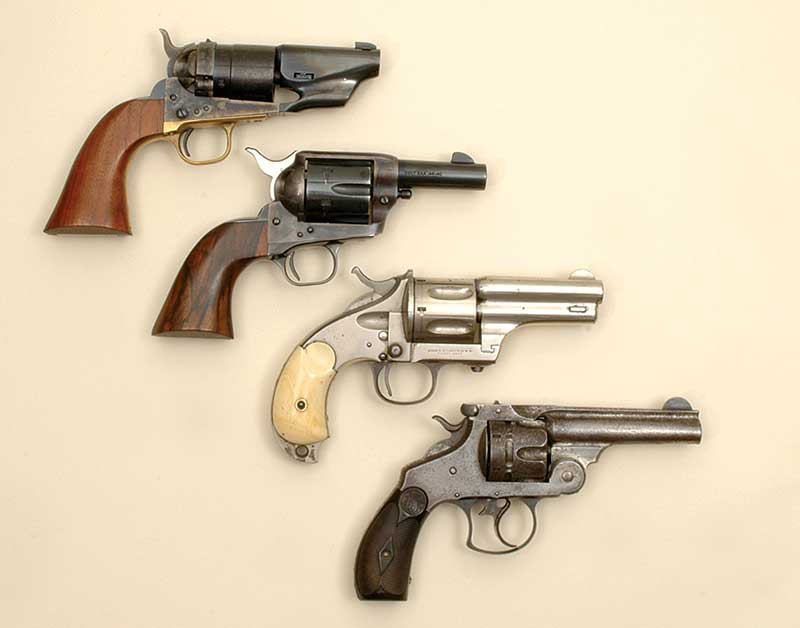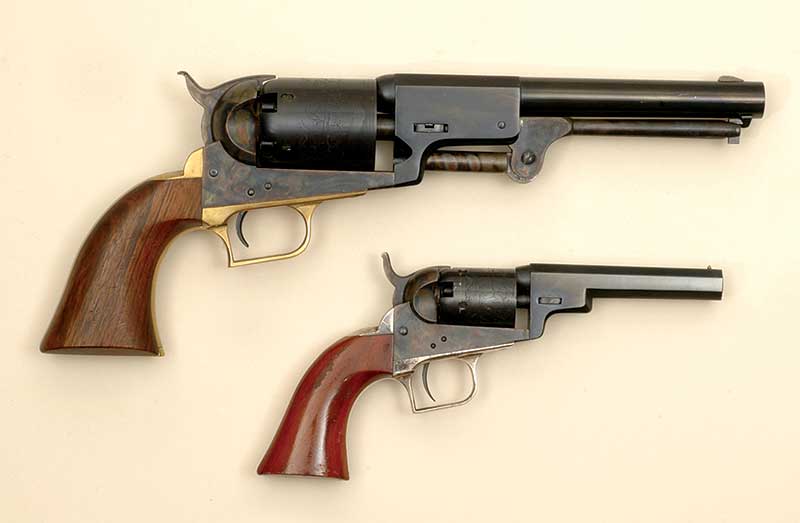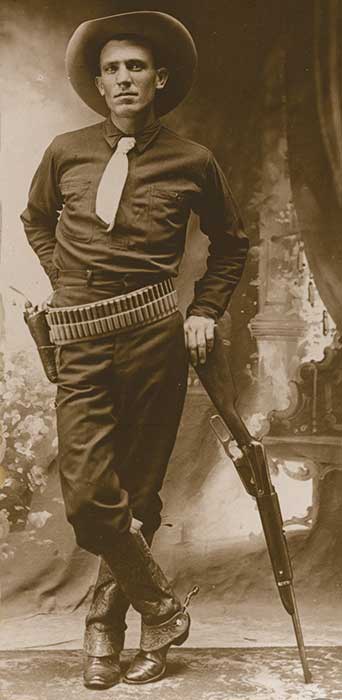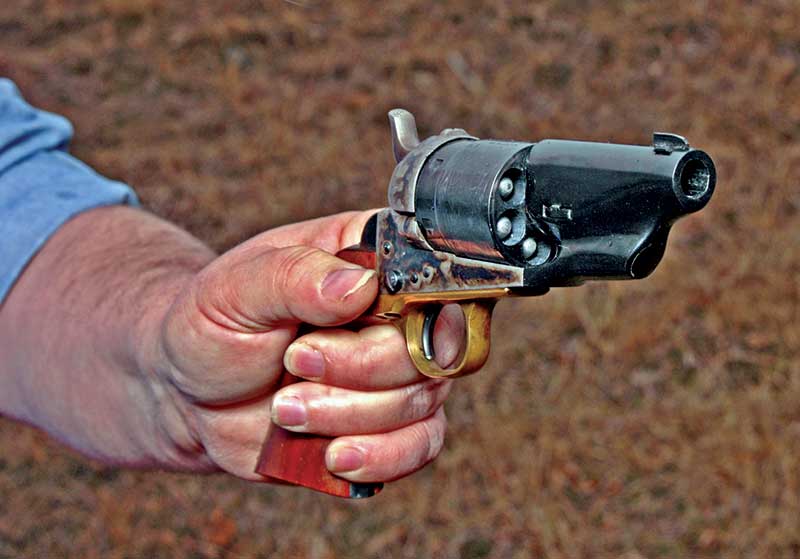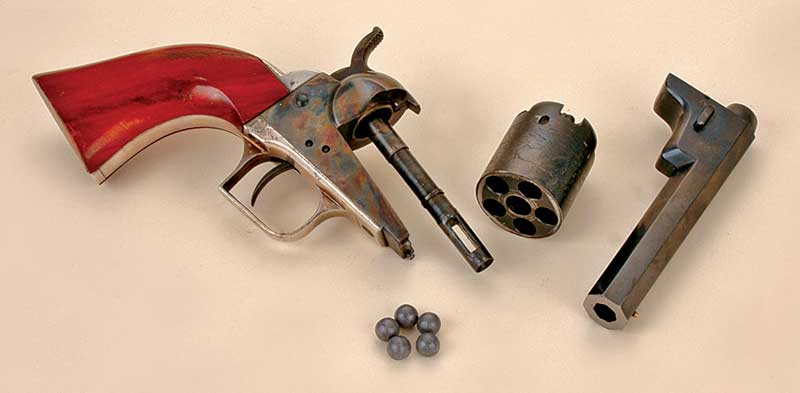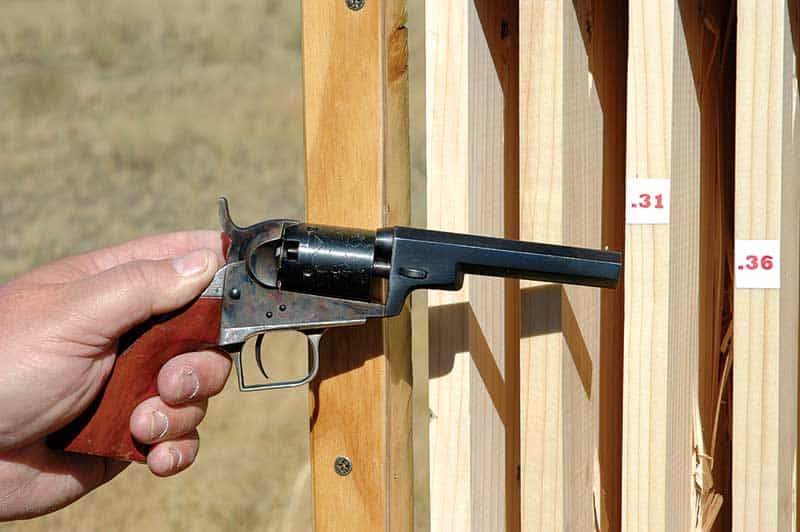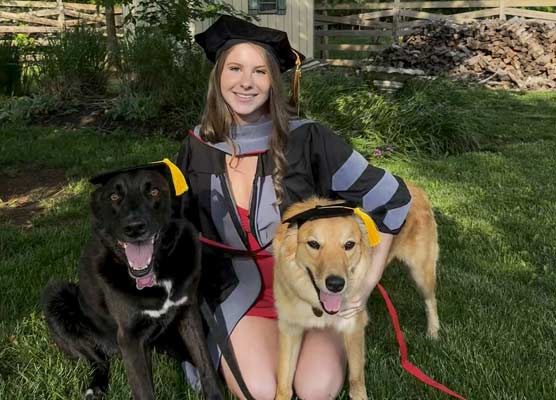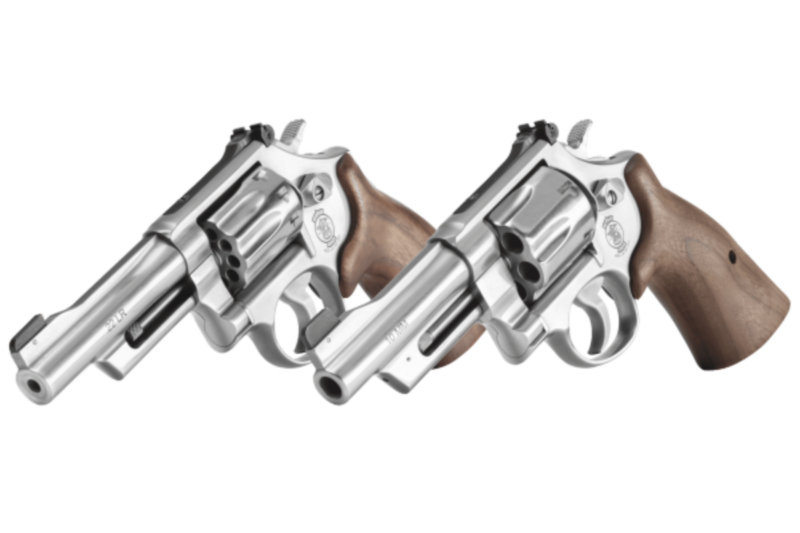Old West CCW
Boot Guns and Baby Dragoons
Hollywood would have us think that back in the “Wild West” every man went about his daily affairs packing a big sixgun in a leather holster on his belt. NOT! Drovers, Frontiersmen and Indian Scouts likely did, and of course Texas Rangers and all sorts of other lawmen certainly carried handguns openly.
Not so town and city dwellers. Pocket pistols were a hot item in the Old West. Town dwellers and well dressed travelers also packed iron, at first actually in pockets. As the trend progressed to bigger and more powerful they were often concealed in a holster under a coat. Consider this; Colt and S&W alone produced well over a million concealment-intended handguns between 1848 and 1900. That’s amazing considering the population of the United States in that era.
Concealable handguns were so hot an item that it’s a fact when Sam Colt got his firearms-manufacturing business up and running the second time in the late 1840s, one of his first concerns was coming up with good “pocket pistols.” That was in 1848 and those little babies were only .31 caliber, and five-shooters to boot. Collectors even call them Baby Dragoons, after the huge 4-pound horse-carried Colt Dragoon revolvers they were based upon. Even by modern standards a Baby Dragoon was light at only 22 ounces with a 4″ barrel.
The Bad News
That was the good news. The bad news was they were punch handicapped. With really hot loads, they were popping to break 700 fps with a 48-grain round ball. In foot-pounds of energy that’s sort of in-between a .22 Short and .22 Long. After those five pipsqueak charges were fired it would take an experienced shooter about 10 minutes to get them up and running again. The gun had to be broken into three pieces for reloading. I doubt if many wayfarers gave up their Bowie knives upon buying a Baby Dragoon.
But get this — Sam Colt sold 15,000 of those little .31s in only a year or so and then upgraded to a Model 1849. It used the same frame but with a loading lever beneath the barrel. Reload time was cut at least in half. Hear this too. The Colt factory turned out more than 325,000 of them before production ceased in 1873. That’s 24 years. It took Colt 68 years and several government contracts to produce 357,000 Colt Peacemakers. Who says people in the old days didn’t carry concealed?
Those gun-toters weren’t stupid either. They knew the little .31s were puny. Using the rebated cylinder design Colt eventually put five-shot .36 caliber cylinders on the little Model 1849 frame and called them Model 1862s. (Collectors named them Pocket Navy and Pocket Police depending on their exact configuration.) Those would push an 80-grain round ball all the way to 850 fps. That brought pocket pistol power up to .32 ACP ballistics. Things were humming then.
Metallic Magic
Now think in terms of metallic cartridges. S&W actually got their business up and rolling in the 1850s and 1860s with concealed-carry-type handguns. This was their No. 1, which actually was the introductory vehicle for the .22 Short. Between 1857 and 1881 they sold over a quarter million of those itsy-bitsy little SAs.
Today’s cowboy-action shooters would be perfectly happy with those puny popguns. Heck they even try to make their big .45s recoil like .22 Shorts. But, back in those days when you didn’t smoke up your assailant’s sorry butt with the handgun, a knife fight likely commenced. People really wanted more power from their CCW guns.
For that reason, in 1876 S&W introduced the .38 S&W cartridge for pocket handguns and the revolver introduced along with it has always been known as the Baby Russian. (Gun people of the late 1800s sure liked that “baby” moniker.) It was so called because the design was scaled down from large frame revolvers the company was making for the Russian Government. A year later Colt came up with their idea of a concealed carry, cartridge firing handgun and this one was even DA! The Colt Model 1877DA was made in .38 Colt and .41 Colt calibers. Somehow they then became dubbed “Lightning” and “Thunderer” respectively.
None of these new concealed weapon calibers struck like lightning. The .38 S&W had loads with 145- to 150-grain bullets over 14 or 15 grains of black powder, while the .38 Colt load used 150-grain bullets over a whopping 19 grains of the same. The .41 Colt was loaded with 200-grain bullets and about 21 grains of black powder. None of these loads could have given over 750 fps, even from a long barreled revolver. Still they were better than a .22 Short. At last people started leaving the Bowie knives at home.
Little Big Guns
Another trend in CCWs got started circa the late 1870s and early 1880s. That was when gun-toters began packing short-barreled versions of big revolvers in holsters under their coats, instead of a diminutive one in their pocket. A for instance would be the so-called Colt SAA Sheriff’s Model with 3″ barrel and no ejector rod or housing. By this time S&W was also making its SA New Model No. 3 with short barrels, and their Model 1881DA was simply the No. 3 adapted to a DA trigger mechanism. It was common with 4″ barrel.
Why the change about that time? Because trouser belts for men became common. Now, I’m no expert on Old West clothing, but my seamstress wife does have some antique pattern catalogs from that era showing men’s pants starting to have belt loops Hence there was finally something to hitch a revolver holster onto without giving obvious notice the wearer was packing iron.
Old West gunmen were also known to have gunsmiths aid them in their quest for concealable handguns, and also to find innovative ways to pack them. For instance around 1881 El Paso City Marshall Dallas Stoudenmire was known to pack a Colt Richards Conversion .44 with its barrel shortened from 8″ to only 3″. Then he had a special leather-lined pocket built into his trousers to house it. By the 1890s shoulder holsters were common. Reformed outlaw John Wesley Hardin was packing either or both a Colt Lightning and S&W Model 1881DA in
such a rig when he was gunned down in an El Paso saloon.
Other Ideas
Some companies got downright brilliant about concealed-carry and self-defense handguns. Merwin & Hulbert for instance offered a Pocket Army .44. It was a normal-sized sixgun and much too large to carry in a pocket. But, they offered the option of two pre-fitted barrels. One was 7″ long and the other 3.5″. They could be switched in a matter of seconds. The idea was for the long barrel to be worn openly on the trail, and then the short one replaced for concealed carry. Then M&H took matters one step further. The revolver’s butt came to a point called the “skullcrusher” for when altercations became more intimate. Wouldn’t lawyers have a field day with that now?
Over the years I’ve managed to add an assortment of Old West concealed carry weapons to my shooting collection of handguns. A Baby Dragoon .31 and both versions of Model 1862 .36s are from Colt’s second generation of cap & ball revolver production of the late 1970s and early 1980s. There’s also an S&W Model 1881DA .44 Russian, a Merwin & Hulbert Pocket Army, and a Colt SAA Sheriff’s Model. Both of those are .44-40s. Some years back I even went to the trouble of having Wisconsin gunsmith Kenny Howell build me a facsimile Richards
Conversion .44 with snubbed-off barrel similar to Dallas Stoudenmire’s favored concealed sixgun. It’s in the original .44 Colt caliber.
The little S&W No. 1s and Baby Russians have eluded me so far but there is a “Baby” Merwin & Hulbert .38 in my collection that is of similar size and power to the S&W Baby Russian. Also, about this time someone is likely thinking, “What about derringers? The dummy is forgetting them.” No I’m not. I’ve just never been interested in them, and won’t blow smoke up your wazoo and say someday I’ll do an article covering derringers. Somebody else can do that. This is a revolver article.
Duke’s Opinion
So here’s my take on Old West concealed-carry handguns. The little .31 caliber Colts were better than nothing, but if you had to take on someone with one you better hope they weren’t wearing a lot of clothing or a heavy leather vest. I shot mine into a baffle box and it went through two 7/8″ pine boards and lodged in the third. I think it was these pipsqueaks that gave rise to the legends
of pocket bibles or a sheriff’s badge stopping a bullet. Ditto in spades for the S&W No. 1 .22 Short.
The S&W Baby Russian and M&H .38s were a great step up. They were still compact enough to actually be pocket-carried, and yet have a modicum of pistol power. There are plenty of accounts about wounds from guns like that causing death from infection days or weeks after a gunfight. Unfortunately, often it was the bad guy that expired weeks later while the good guy was beaten or knifed to death at the scene. They weren’t stoppers.
That leaves us with the short-barreled, big-bore revolvers meant to be holster-carried. Actually they were pretty good self-defense handguns. The .44 Russian would have had a 246- to 255-grain bullet over 23 grains of black powder. From a 3″ or 4″ barrel that load gives 725 to 750 fps. The .44-40 load would have a 200- grain bullet over a full 40-grain charge. It was snorty! Even from a 3″ or 3.5″ barrel it will break 800 fps. If none of that impresses you “modern” guys then just think again. In terms of muzzle energy those ballistics pretty much equal a .45 ACP from one of the compact Model 1911s.
Personally, if I had been walking the streets of a tough town in the 1880s, and had my choice of what to carry concealed, it would be a toss up between the S&W Model 1881DA .44 Russian, or the Merwin & Hulbert .44-40. The Colt Sheriff’s Model .44-40 is attractive but it would be my third choice just because of the slow reload factor. Both the S&W and M&H offer simultaneous cartridge extraction.
And then I would have slipped an S&W or M&H “Baby” .38 in a pocket for backup — and had a knife in my boot too. And if you were a bad guy after me then, you might keep in mind I might have a good friend nearby equally ready. Like Clint Smith says, “Always cheat, always win.”
Subscribe To American Handgunner

Get More Revolver Content Every Week!
Sign up for the Wheelgun Wednesday newsletter here:

